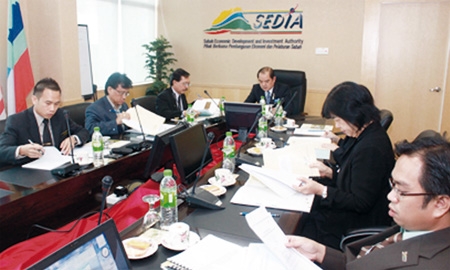The State of Sabah in northern Borneo is one of the most naturally diverse areas of Malaysia. The location of the world’s oldest rainforest, it is home to rare wildlife, such as the orang-utan, proboscis monkeys, pygmy elephants and the endangered Sumatran rhinoceros, as well as a rich variety of bird life. The emerald green seas that wash its tropical beaches enclose a fascinating underwater world of magnificent coral reefs, sea turtles, giant clams and many kinds of tropical fish.
With so much to offer the visitor, Sabah is Malaysia’s premier nature destination and tourism is an important aspect of the local economy. But Sabah’s potential for economic activity extends beyond tourism alone. Over the next decade and a half every effort will be made to develop that potential to the benefit of the people living in the state.
The Sabah Development Corridor (SDC), launched in 2008, is the most recent of Malaysia’s five development corridors. Covering the whole state, its 18-year development plan is in the second of three phases of implementation.
The first phase, which ended last year, focused on laying foundations for growth through development of infrastructure, and economic and poverty eradication projects. The current second phase, which runs until 2015, aims to accelerate economic growth by promoting value-added economic activities, attracting global companies and building a strong base of local small and medium-sized enterprises.
“WE WOULD LIKE TO PROMOTE NEW SOURCES OF GROWTH, SUCH AS GREEN INDUSTRIES, BIOTECH, ICT AND CREATIVE INDUSTRIES, WHILE ENSURING SUSTAINABLE UTILISATION OF OUR NATURAL RESOURCES AND PRESERVING
OUR NATURAL ENVIRONMENT” DATUK DR MOHD YAAKUB HJ JOHARI
Chief Executive of SEDIA |
The final, third, phase from 2016 to 2025 foresees further expansion of the economy, as well as the emergence of a state with strong supporting infrastructure, global companies and an educated work force that is an attractive destination for foreign direct investment.
Charged with bringing all this about is the Sabah Economic Development and Investment Authority (SEDIA), a one-stop authority working in partnership with the Government, the private sector and the civil society.
SEDIA’s chief executive Datuk Dr Mohd Yaakub Hj Johari says the goals of the SDC are to eradicate poverty, enhance the quality of life, promote economic growth and ensure balanced, equitable and sustainable development. He believes Sabah’s key strengths are its strategic location, abundant natural resources, rich cultural heritage and access to mega biodiversity resources.
“We would like to make Sabah a destination for business, culture and nature,” he says. “Investors are welcome to do business in Sabah while at the same time savouring our unique cultural experience, as well as having a first-hand appreciation of our world-renowned marine attractions, rare wildlife and lush tropical rain forest.”
As far as tourism is concerned, the idea is to turn Sabah into a high-end lifestyle destination attracting luxury holiday visitors to signature resorts. Agriculture is another promising sector – Sabah is already Malaysia’s biggest contributor to oil palm production – and SEDIA also aims to encourage the development of logistic services and manufacturing.
“We think there is a lot of potential in these areas,” says Dr Yaakub.
Sabah is particularly keen to attract knowledge-intensive industries and already collaborates with British scientists and researchers at the Danum Valley Field Research Centre, which is recognised by the Royal Society.
“To maintain the attractiveness of Sabah in the long term,” he adds, “we would also like to promote new sources of growth, such as the green industries, biotech, ICT and creative industries, while at the same time ensuring sustainable utilisation of our natural resources and preserving our natural environment.”

0 COMMENTS